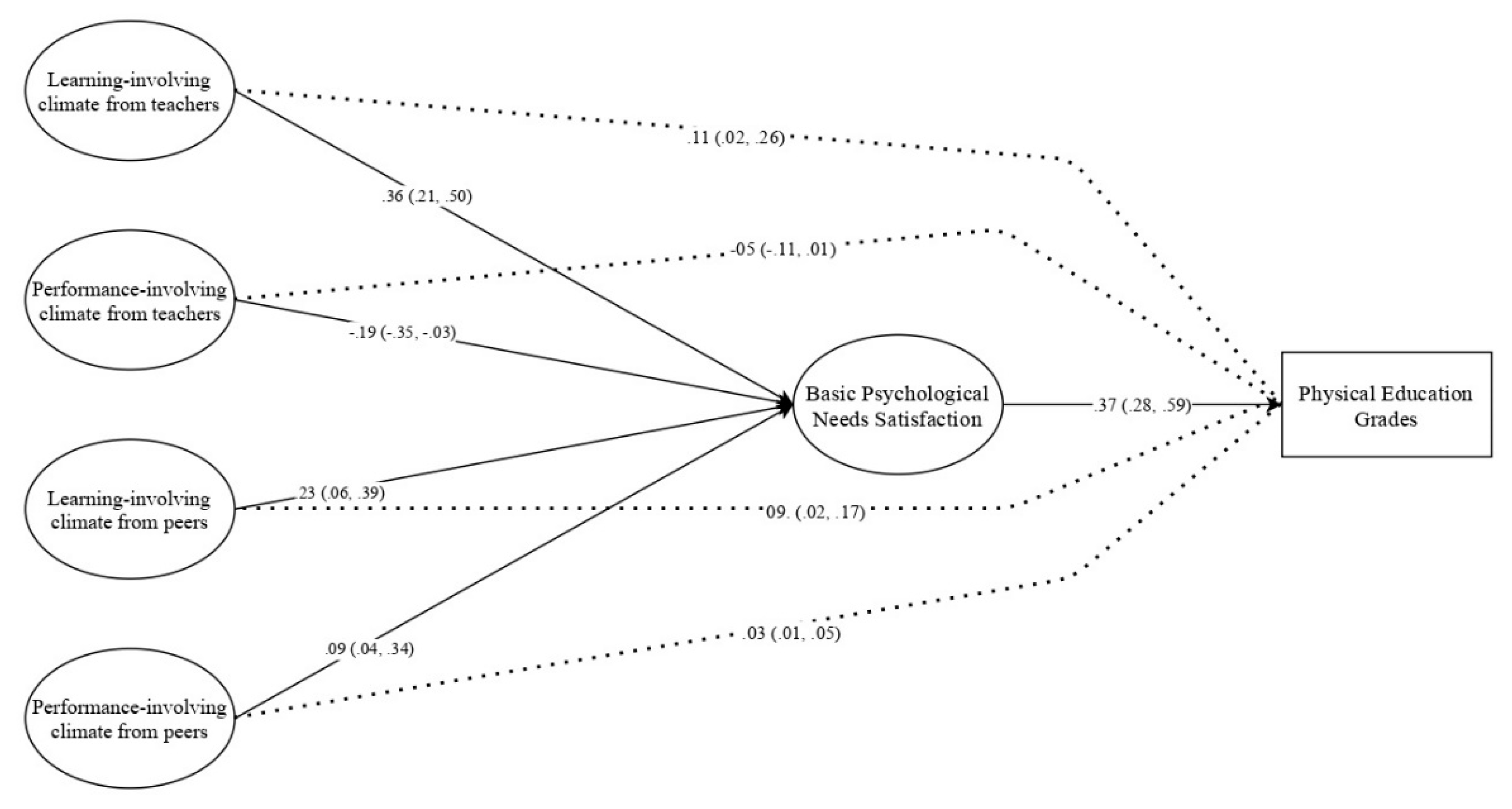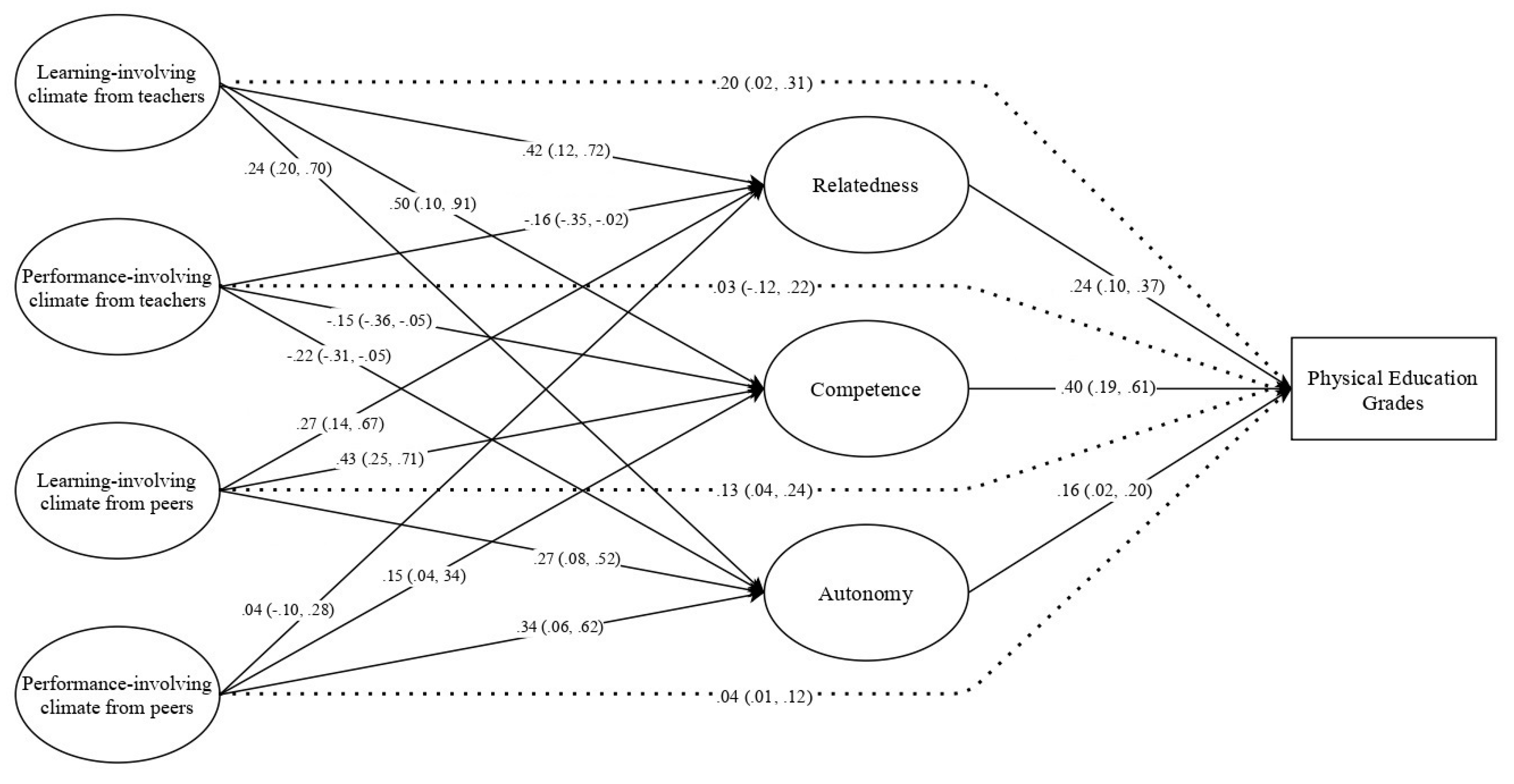The Relationship between Teachers and Peers’ Motivational Climates, Needs Satisfaction, and Physical Education Grades: An AGT and SDT Approach
Abstract
1. Introduction
1.1. Theoretical Frameworks in Physical Education Settings
1.2. An Integrated Model of AGT and SDT in Physical Education Settings
1.3. The Relationship between Motivational Climates, Needs Satisfaction, and Academic Performance
1.4. Current Research
2. Materials and Methods
2.1. Participants and Procedures
2.2. Measures
2.3. Statistical Analysis
3. Results
3.1. Preliminary Results
3.2. Structural Model
4. Discussion
4.1. Strengths, Limitations, and Agenda for Future Research
4.2. Practical Implications
5. Conclusions
Author Contributions
Funding
Conflicts of Interest
References
- Ryan, R.; Deci, E. Self-determination theory. In Basic Psychological Needs in Motivation, Development, and Wellness; Guilford Press: New York, NY, USA, 2017. [Google Scholar]
- Cid, L.; Pires, A.; Borrego, C.; Duarte-Mendes, P.; Teixeira, D.; Moutão, J.M.; Monteiro, D. Motivational determinants of physical education grades and the intention to practice sport in the future. PLoS ONE 2019, 14, e0217218. [Google Scholar] [CrossRef] [PubMed]
- Jaakkola, T.; Wang, C.K.J.; Soini, M.; Liukkonen, J. Students’ Perceptions of Motivational Climate and Enjoyment in Finnish Physical Education: A Latent Profile Analysis. J. Sports Sci. Med. 2015, 14, 477–483. [Google Scholar] [PubMed]
- Warburton, V.E. Peer and teacher influences on the motivational climate in physical education: A longitudinal perspective on achievement goal adoption. Contemp. Educ. Psychol. 2017, 51, 303–314. [Google Scholar] [CrossRef]
- Ames, C. Achievement goals, motivational climate and motivational processes. In Motivation in Sport and Exercise; Roberts, G., Ed.; Human Kinetics: Champaign, IL, USA, 1992; pp. 161–176. [Google Scholar]
- Nicholls, J.G. Achievement motivation: Conceptions of ability, subjective experience, task choice, and performance. Psychol. Rev. 1984, 91, 328–346. [Google Scholar] [CrossRef]
- Treasure, D.C.; Robert, G.C. Students’ Perceptions of the Motivational Climate, Achievement Beliefs, and Satisfaction in Physical Education. Res. Q. Exerc. Sport 2001, 72, 165–175. [Google Scholar] [CrossRef]
- Papaioannou, A. Development of a Questionnaire to Measure Achievement Orientations in Physical Education. Res. Q. Exerc. Sport 1994, 65, 11–20. [Google Scholar] [CrossRef]
- Papaioannou, A. Students’ Perceptions of the Physical Education Class Environment for Boys and Girls and the Perceived Motivational Climate. Res. Q. Exerc. Sport 1998, 69, 267–275. [Google Scholar] [CrossRef]
- Calderón, A.; Meroño, L.; MacPhail, A. A student-centered digital technology approach: The relationship between intrinsic motivation, learning climate and academic achievement of physical education pre-service teachers. Eur. Phys. Edu. Rev. 2019, 26, 241–262. [Google Scholar] [CrossRef]
- Gråstén, A.; Watt, A. A Motivational Model of Physical Education and Links to Enjoyment, Knowledge, Performance, Total Physical Activity and Body Mass Index. J. Sports Sci. Med. 2017, 16, 318–327. [Google Scholar]
- Gråstén, A.; Jaakkola, T.; Liukkonen, J.; Watt, A.; Yli-Piipari, S. Prediction of Enjoyment in School Physical Education. J. Sports Sci. Med. 2012, 11, 260–269. [Google Scholar]
- Gråstén, A.; Watt, A.; Jaakkola, T.; Liukkonen, J.; Yli-Piipari, S. Effectiveness of School-Initiated Physical Activity Program on Secondary School Students’ Physical Activity Participation. J. Sch. Heal. 2015, 85, 125–134. [Google Scholar] [CrossRef]
- Vansteenkiste, M.; Ryan, R. On psychological growth and vulnerability: Basic psychological need satisfaction and need frustration as a unifying principle. J. Psychother. Integr. 2013, 23, 263–280. [Google Scholar] [CrossRef]
- Moreno-Murcia, J.A.; Hernández, E.H.; Cid, L.; Monteiro, D.; Rodrigues, F.; Teixeira, D.; Walle, J.L.; Vergara-Torres, A.; Tristan, J.; Gastélum-Cuadras, G.; et al. Assessing the Relationship between Autonomy Support and Student Group Cohesion across Ibero-American Countries. Int. J. Environ. Res. Public Health 2020, 17, 3981. [Google Scholar] [CrossRef]
- Hernández, E.H.; Moreno-Murcia, J.A.; Cid, L.; Monteiro, D.; Rodrigues, F. Passion or Perseverance? The Effect of Perceived Autonomy Support and Grit on Academic Performance in College Students. Int. J. Environ. Res. Public Health 2020, 17, 2143. [Google Scholar] [CrossRef] [PubMed]
- Duda, J.; Appleton, P.; Stebbings, J.; Balaguer, I. Towards more empowering and less disempowering environments in youth sport. In Sport Psychology for Young Athletes; Knight, C.J., Harwood, C.G., Gould, D., Eds.; Routledge: Abingdon, UK, 2017. [Google Scholar]
- Reinboth, M.; Duda, J.L. Perceived motivational climate, need satisfaction and indices of well-being in team sports: A longitudinal perspective. Psychol. Sport Exerc. 2006, 7, 269–286. [Google Scholar] [CrossRef]
- Serrano, J.S.; Solana, A.A.; Catalan, A.A.; Gonzalez, L.G. Motivational climate of teaching physical education: Could it affect student grades? RETOS 2017, 31, 98–102. [Google Scholar]
- García-González, L.; Sevil-Serrano, J.; Ángel, A.; Aelterman, N.; Haerens, L. The role of task and ego-oriented climate in explaining students’ bright and dark motivational experiences in Physical Education. Phys. Educ. Sport Pedagog. 2019, 24, 344–358. [Google Scholar] [CrossRef]
- Pineda-Espejel, H.A.; Walle, J.L.; Tomas, I.M. Situational and Dispositional Factors that Predict Motivation: A Multilevel Study. Span. J. Psychol. 2017, 20, 365. [Google Scholar] [CrossRef]
- Weeldenburg, G.; Borghouts, L.B.; Slingerland, M.; Vos, S. Similar but different: Profiling secondary school students based on their perceived motivational climate and psychological need-based experiences in physical education. PLoS ONE 2020, 15, e0228859. [Google Scholar] [CrossRef]
- Braithwaite, R.; Spray, C.M.; Warburton, V.E. Motivational climate interventions in physical education: A meta-analysis. Psychol. Sport Exerc. 2011, 12, 628–638. [Google Scholar] [CrossRef]
- Harwood, C.G.; Keegan, R.J.; Smith, J.M.; Raine, A.S. A systematic review of the intrapersonal correlates of motivational climate perceptions in sport and physical activity. Psychol. Sport Exerc. 2015, 18, 9–25. [Google Scholar] [CrossRef]
- Warburton, V.E.; Spray, C. Antecedents of approach-avoidance achievement goal adoption: An analysis of two physical education activities. Eur. Phys. Educ. Rev. 2013, 19, 215–231. [Google Scholar] [CrossRef]
- Claver, F.; Martínez-Aranda, L.M.; Conejero, M.; Gil-Arias, A. Motivation, Discipline, and Academic Performance in Physical Education: A Holistic Approach from Achievement Goal and Self-Determination Theories. Front. Psychol. 2020, 11. [Google Scholar] [CrossRef]
- Gutiérrez, M.; Lopez, E. Motivación, comportamiento de los alumnos y rendimiento académico. Aprendiz 2012, 35, 61–72. [Google Scholar] [CrossRef]
- Taylor, G.; Jungert, T.; Mageau, G.A.; Schattke, K.; Dedic, H.; Rosenfield, S.; Koestner, R. A self-determination theory approach to predicting school achievement over time: The unique role of intrinsic motivation. Contemp. Educ. Psychol. 2014, 39, 342–358. [Google Scholar] [CrossRef]
- Leon, J.; Núñez, J.L.; Liew, J. Self-determination and STEM education: Effects of autonomy, motivation, and self-regulated learning on high school math achievement. Learn. Individ. Differ. 2015, 43, 156–163. [Google Scholar] [CrossRef]
- Pires, A.; Cid, L.; Borrego, C.; Alves, J.; Silva, C.M.M. Validação preliminar de um questionário para avaliar as necessidades psicológicas básicas em Educação Física. Motricidade 2010, 6, 33–51. [Google Scholar] [CrossRef]
- Cid, L.; Rodrigues, F.; Teixeira, D.S.; Alves, J.; Machado, S.; Murillo-Rodriguez, E.; Monteiro, D. Exploração de um modelo de segunda ordem da Versão Portuguesa da Basic Psychological Needs in Exercise Scale (BPNESp): Validade do constructo e invariância. Cuadernos Psicología Deporte 2020, 20, 95–111. [Google Scholar] [CrossRef]
- Arbuckle, J. IBM® SPSS® Amos™ 22 User’s Guide; IBM Corp: Armonk, NY, USA, 2013. [Google Scholar]
- Gravetter, F.; Wallnau, L. Essentials of Statistics for the Behavioral Sciences, 8th ed.; Cengage Learning Wadsworth: Belmont, CA, USA, 2014. [Google Scholar]
- Raykov, T. Estimation of Composite Reliability for Congeneric Measures. Appl. Psychol. Meas. 1997, 21, 173–184. [Google Scholar] [CrossRef]
- Muthén, L.K.; Muthén, B.O. Mplus User’s Guide, 6th ed.; Muthén & Muthén: Los Angeles, CA, USA, 2010. [Google Scholar]
- Byrne, B.M. Structural Equation Modeling with Mplus: Basic Concepts, Applications and Programming, 3rd ed.; Routledge: Abingdon, UK, 2011. [Google Scholar]
- Hair, J.F.; Black, W.C.; Babin, B.J.; Anderson, R.E. Multivariate Data Analysis, 8th ed.; Cengage: Boston, MA, USA, 2019. [Google Scholar]
- Marsh, H.W.; Hau, K.-T.; Wen, Z. In Search of Golden Rules: Comment on Hypothesis-Testing Approaches to Setting Cutoff Values for Fit Indexes and Dangers in Overgeneralizing Hu and Bentler’s (1999) Findings. Struct. Equ. Model. 2004, 11, 320–341. [Google Scholar] [CrossRef]
- Williams, J.; MacKinnon, D.P. Resampling and Distribution of the Product Methods for Testing Indirect Effects in Complex Models. Struct. Equ. Model. 2008, 15, 23–51. [Google Scholar] [CrossRef]
- Teixeira, D.S.; Pelletier, L.G.; Monteiro, D.; Rodrigues, F.; Moutão, J.; A Marinho, D.; Cid, L. Motivational patterns in persistent swimmers: A serial mediation analysis. Eur. J. Sport Sci. 2019, 1–10. [Google Scholar] [CrossRef] [PubMed]
- Rodrigues, F.; Macedo, R.; Cid, L.; Teixeira, D.S.; Marinho, D.A.; Monteiro, D. Sex Differences in Relationships Between Perceived Coach-Induced Motivational Climates, Basic Psychological Needs, and Behavior Regulation Among Young Swimmers. Percept. Mot. Ski. 2020. [Google Scholar] [CrossRef] [PubMed]
- Bortoli, L.; Bertollo, M.; Filho, E.; Di Fronso, S.; Robazza, C. Implementing the TARGET Model in Physical Education: Effects on Perceived Psychobiosocial and Motivational States in Girls. Front. Psychol. 2017, 8, 1517. [Google Scholar] [CrossRef] [PubMed]
- Roberts, G.C.; Treasure, D.C.; Kavussanu, M. Orthogonality of Achievement Goals and Its Relationship to Beliefs about Success and Satisfaction in Sport. Sport Psychol. 1996, 10, 398–408. [Google Scholar] [CrossRef]
- Elliot, A.J.; McGregor, H.A. A 2 × 2 achievement goal framework. J. Pers. Soc. Psychol. 2001, 80, 501–519. [Google Scholar] [CrossRef]


| Variables | M | SD | S | K | Correlations | ||||||
|---|---|---|---|---|---|---|---|---|---|---|---|
| 1 | 2 | 3 | 4 | 5 | 6 | 7 | |||||
| 1. LO climate created by Teachers | 4.20 | 0.63 | −0.40 | 0.27 | 0.79 | ||||||
| 2. PO climate created by Teacher | 3.52 | 0.86 | −0.20 | −0.17 | 0.08 | 0.72 | |||||
| 3. LO climate created by Peers | 4.50 | 0.58 | −0.69 | −0.20 | 0.65 ** | 0.25 ** | 0.81 | ||||
| 4. PO climate created by Peers | 2.39 | 0.91 | 0.33 | −0.13 | −0.16 * | 0.33 ** | −0.33 ** | 0.72 | |||
| 5. Autonomy Satisfaction | 3.30 | 0.72 | −0.58 | 0.09 | 0.30 ** | −0.24 * | 0.38 ** | 0.34 ** | 0.70 | ||
| 6. Competence Satisfaction | 3.71 | 0.67 | −0.37 | 0.08 | 0.49 ** | −0.11 * | 0.37 ** | 0.20 ** | 0.43 ** | 0.87 | |
| 7. Relatedness Satisfaction | 4.15 | 0.78 | −1.07 | 0.08 | 0.52 ** | −0.74 * | 0.48 ** | −0.06 | 0.50 ** | 0.32 ** | 0.78 |
| 8. Physical Education Grades | 3.38 | 0.66 | 0.12 | 0.04 | 0.28 ** | 0.08 | 0.30 ** | −0.16 ** | 0.22 ** | 0.37 ** | 0.39 ** |
© 2020 by the authors. Licensee MDPI, Basel, Switzerland. This article is an open access article distributed under the terms and conditions of the Creative Commons Attribution (CC BY) license (http://creativecommons.org/licenses/by/4.0/).
Share and Cite
Rodrigues, F.; Monteiro, D.; Teixeira, D.S.; Cid, L. The Relationship between Teachers and Peers’ Motivational Climates, Needs Satisfaction, and Physical Education Grades: An AGT and SDT Approach. Int. J. Environ. Res. Public Health 2020, 17, 6145. https://doi.org/10.3390/ijerph17176145
Rodrigues F, Monteiro D, Teixeira DS, Cid L. The Relationship between Teachers and Peers’ Motivational Climates, Needs Satisfaction, and Physical Education Grades: An AGT and SDT Approach. International Journal of Environmental Research and Public Health. 2020; 17(17):6145. https://doi.org/10.3390/ijerph17176145
Chicago/Turabian StyleRodrigues, Filipe, Diogo Monteiro, Diogo S. Teixeira, and Luís Cid. 2020. "The Relationship between Teachers and Peers’ Motivational Climates, Needs Satisfaction, and Physical Education Grades: An AGT and SDT Approach" International Journal of Environmental Research and Public Health 17, no. 17: 6145. https://doi.org/10.3390/ijerph17176145
APA StyleRodrigues, F., Monteiro, D., Teixeira, D. S., & Cid, L. (2020). The Relationship between Teachers and Peers’ Motivational Climates, Needs Satisfaction, and Physical Education Grades: An AGT and SDT Approach. International Journal of Environmental Research and Public Health, 17(17), 6145. https://doi.org/10.3390/ijerph17176145







